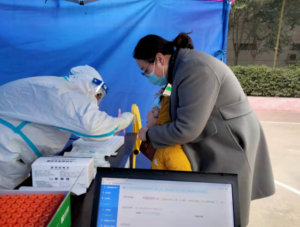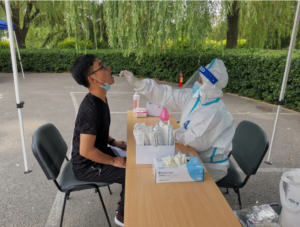
See the doctor, see the medicine, see the cadres! Departments across Guizhou province make all-out efforts to grasp the prevention and control of epidemics in rural areas
From January 8, the new coronavirus infection will be adjusted from “Category B A control” to “Category B B control”, and the epidemic prevention and control will enter a new stage.
The number of elderly people and children in rural areas is huge, and medical resources are relatively weak. The province is also a major labor exporting province, and near the Spring Festival, there will be a tide of migrant workers returning home. According to monitoring, the infection rate in rural areas of the province has exceeded 60%. How to do a good job of prevention and control of the epidemic in rural areas, is the province is facing a “big test”.
In this regard, the provincial party committee and provincial government attaches great importance to a series of deployments. Over the past few days, various departments around the province around the “health, prevention of serious illnesses”, make concerted efforts to carry out prevention and control of epidemics in rural areas, and strive to improve the “see the doctor rate, see the rate of drugs, see the dry rate”, to maximize the protection of people’s lives and health.

Chishui “health cavalry” will send medical services into the village
Let the masses see the “white coat” at the first time
Rural areas are wide, populous and thin, with a weak foundation of medical and health resources and insufficient medical service capacity compared to urban areas. With the development of the epidemic, timely access to medical care has become the most urgent need of the rural people.
On January 2, at the community health service center in Yuzhuan Street, Meitan County, patients were seeking medical treatment in an orderly manner. In the fever clinic, the doctor carefully inquired about the patient’s condition, guided the use of medication and treated the symptoms.
Patient Yu Jiaqi is on his third day of hospitalization and has basically recovered and will be discharged soon. He usually lives in a home for the elderly, and his symptoms are more serious after he was infected with the new coronavirus. After learning of the situation, the fever tour service van of the community health service center came to his home to pick him up and admit him to the hospital at the first time. “The health care workers cared for me very much, thank them very much!” Yu Jiaqi said.
At present, the province has set up 647 fever clinics in hospitals above the second level, 1,665 fever clinics in primary health care institutions and 16,165 fever treatment points at the village level. Nearly 1,000 traveling medical teams have been sent down from counties to towns to carry out traveling medical treatment; community health service centers in township health centers have sunk more than 20,000 medical personnel to carry out treatment at the village level.
Yang Hui, party secretary of the provincial health committee, said the province’s health and health system around the “health protection, prevention of serious illness”, focusing on the operation of the epidemic prevention system in rural areas, treatment of serious illnesses, protection of key populations and other work, the first time for the people to see the “white coat” In order to protect the lives and health of rural residents to the greatest extent possible.

Qixingguan District People’s Hospital of Bijie City
All efforts are made to let the public buy and use good medicine
With the development of the new coronavirus infection in the province to the rural areas, the demand for medicines for the rural people is growing rapidly.
On January 1, medical and nursing volunteers from Loushanguan Street Community Health Service Center in Tongzi County sent the voluntary medical service to the homes of the masses, sending them a warmth in this cold winter.
This time, medical and nursing staff visited a total of 193 key people in the district, according to the actual situation and the needs of the masses, free distribution of relevant drugs and materials, carefully explained the dosage.
In Kaili City and Chishui City, people were encouraged to contribute their extra medicines by setting up “shared medicine boxes”.
After the “shared medicine box” was set up, many people after the “Yang Kang” have donated the remaining cold and fever medicine to the “shared medicine box” and provided it to the people who need it for free.
On January 2, the province launched to the province’s 1.33 million people aged 65 and above key people, each issued a “epidemic prevention health kit” to guide the elderly to strengthen protection, scientific prevention, reasonable use of drugs, so that the people feel at ease.
Over the past few days, the provincial Department of Industry and Information Technology has done everything possible to strengthen the coordination and scheduling, increase the procurement of drugs, organize the province’s pharmaceutical enterprises to produce at full capacity, actively apply for national support, online and offline to strengthen the precise placement of drugs. With the relevant work, the problem of drug supply shortage is gradually alleviated.
“We pay close attention to the production, supply, circulation and delivery of drugs, and make every effort to enable the rural people to buy and use drugs.” Li Wei, director of the provincial Department of Industry and Information Technology, said that the next step will be to work with health, agriculture and rural areas, drug supervision and other departments to further focus on key drugs and supplies to identify demand, improve the accuracy and timeliness of supply, and timely meet the needs of the grassroots and the masses with drugs, so that folks can spend a safe and healthy Spring Festival without fear.

In order to meet the needs of the masses with drugs, Meitan major pharmacies also timely replenishment of supplies
Like grasping the poverty alleviation attack to grasp the rural epidemic prevention and control
In the past few days, the grassroots cadres in the town of Yongwen, Kaiyang County, have been extraordinarily busy. The “small speakers” in each village broadcast epidemic prevention knowledge and general health awareness in a circular manner, and party volunteers wearing red vests are often seen going to the villages and households.
Forty-eight town and village cadres and party volunteers were selected to form six anti-epidemic party vanguard teams and one emergency security team to carry out regular epidemic prevention and control work in five villages and one community in the town.
In Jianhe County, since December 2022, more than 300 village health workers across the county have been busy in their respective villages, delivering medicines, infusions, injections and examinations to provide the most basic protection for the health of villagers.
In the face of the epidemic, the cadres are the backbone of the villagers. As the “guardian” of the village, they run around the countryside every day to carry out “door-knocking action” and become the “errand boy” and “guardian” of the villagers’ health. “.
“We have to grasp the current rural epidemic prevention and control work as well as poverty alleviation.” Zhang Jiji, director of the provincial agricultural office and director of the provincial Department of Agriculture and Rural Affairs, said he would do his best to promote the implementation of the “five-level secretary”, establish a provincial coordination, city and state scheduling, county and village grasp the implementation of the work mechanism, improve the work of the rural epidemic prevention and control work team work mechanism, set up nine supervisory groups to carry out comprehensive supervision and inspection in the province, play the rural grassroots organizations Especially the role of the first secretary and task force in villages, rural party members and other main forces, to achieve full coverage of the rural areas, the elderly, people with disabilities, maternity, left-behind children and other key groups of contact support. At the same time, play the role of 86 counties in the county steering group, co-ordinate the epidemic prevention and control and agricultural production stability and supply, to provide strong support for the prevention and control of the epidemic in rural areas.


Average Rating